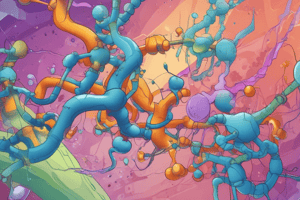Podcast
Questions and Answers
What type of molecules are enzymes?
What type of molecules are enzymes?
- Protein molecules (correct)
- Lipid molecules
- RNA molecules
- Carbohydrate molecules
What is the function of enzymes in cellular activity?
What is the function of enzymes in cellular activity?
- Maintaining temperature
- Speeding up chemical reactions (correct)
- Regulation of pH
- Stabilizing hormones
What is the main characteristic of enzymes in relation to their substrates?
What is the main characteristic of enzymes in relation to their substrates?
- They have no effect on substrates
- They have high specificity (correct)
- They have low specificity
- They form covalent bonds with substrates
Under what conditions do enzymes function?
Under what conditions do enzymes function?
What is the main role of an enzyme in a chemical reaction?
What is the main role of an enzyme in a chemical reaction?
What is the specific molecular environment provided by enzymes for chemical reactions?
What is the specific molecular environment provided by enzymes for chemical reactions?
What is the main factor that the Gibbs Free Energy (∆Go) depends on?
What is the main factor that the Gibbs Free Energy (∆Go) depends on?
In which type of reaction does the free-energy change (∆G) have a negative value?
In which type of reaction does the free-energy change (∆G) have a negative value?
In which type of reaction do the products contain more free energy than the reactants?
In which type of reaction do the products contain more free energy than the reactants?
What happens to the reaction when ∆G is large and negative?
What happens to the reaction when ∆G is large and negative?
In competitive inhibition, how does the intercept on the plot of 1/V versus 1/[S] change in the presence of inhibitor?
In competitive inhibition, how does the intercept on the plot of 1/V versus 1/[S] change in the presence of inhibitor?
What is the energy that cells can and must use, described by the Gibbs free-energy function G?
What is the energy that cells can and must use, described by the Gibbs free-energy function G?
What is the main effect of noncompetitive inhibition on Vmax and the intercept on the vertical axis?
What is the main effect of noncompetitive inhibition on Vmax and the intercept on the vertical axis?
What is the main function of the Michaelis-Menten model in enzymatic reactions?
What is the main function of the Michaelis-Menten model in enzymatic reactions?
Which type of inhibition cannot be overcome by increasing the concentration of substrate?
Which type of inhibition cannot be overcome by increasing the concentration of substrate?
What does Km represent in the Michaelis-Menten equation?
What does Km represent in the Michaelis-Menten equation?
What is the characteristic feature of irreversible inhibitors?
What is the characteristic feature of irreversible inhibitors?
What does Vmax indicate in enzymatic reactions?
What does Vmax indicate in enzymatic reactions?
What is the role of modulators in allosteric enzymes?
What is the role of modulators in allosteric enzymes?
What does a large and negative ∆G value indicate for a chemical reaction under standard conditions?
What does a large and negative ∆G value indicate for a chemical reaction under standard conditions?
What is the effect of competitive inhibitors on Km and Vmax?
What is the effect of competitive inhibitors on Km and Vmax?
What does a large and positive ∆G value indicate for a chemical reaction?
What does a large and positive ∆G value indicate for a chemical reaction?
Which type of inhibition involves simultaneous binding of inhibitor and substrate to the enzyme?
Which type of inhibition involves simultaneous binding of inhibitor and substrate to the enzyme?
What is unique for each enzyme and inversely proportional to its affinity for the substrate?
What is unique for each enzyme and inversely proportional to its affinity for the substrate?
What is a characteristic feature of reversible competitive inhibitors?
What is a characteristic feature of reversible competitive inhibitors?
In what conditions does Vmax occur during an enzymatically catalyzed reaction?
In what conditions does Vmax occur during an enzymatically catalyzed reaction?
What distinguishes allosteric enzymes from Michaelis-Menten enzymes?
What distinguishes allosteric enzymes from Michaelis-Menten enzymes?
In noncompetitive inhibition, what happens to Km and Vmax?
In noncompetitive inhibition, what happens to Km and Vmax?
Which type of inhibitors competitively bind to allosteric sites instead of active sites?
Which type of inhibitors competitively bind to allosteric sites instead of active sites?
Which type of NSAID inhibits only COX-2?
Which type of NSAID inhibits only COX-2?
What is the function of COX-1 according to the widely held belief?
What is the function of COX-1 according to the widely held belief?
Which type of pain directly results from a lesion in nerves and the somatosensory system?
Which type of pain directly results from a lesion in nerves and the somatosensory system?
What is the primary function of NSAIDs?
What is the primary function of NSAIDs?
Which NSAID is classified as a non-selective inhibitor of COX?
Which NSAID is classified as a non-selective inhibitor of COX?
What is the main effect of selective NSAIDs?
What is the main effect of selective NSAIDs?
Which type of NSAID is known for its antipyretic action?
Which type of NSAID is known for its antipyretic action?
What is the primary source of belief regarding the production of PGs by COX-1 and COX-2?
What is the primary source of belief regarding the production of PGs by COX-1 and COX-2?
Which type of pain affects structures in the mouth, such as gingival and subgingival tissue?
Which type of pain affects structures in the mouth, such as gingival and subgingival tissue?
"Arthrotec" is a combination of which two compounds known for inhibiting COX?
"Arthrotec" is a combination of which two compounds known for inhibiting COX?
Which type of amino acids in the active site directly participate in the chemical reaction?
Which type of amino acids in the active site directly participate in the chemical reaction?
What type of molecules are holoenzymes?
What type of molecules are holoenzymes?
What is the region in the enzyme molecule where the enzymatic catalysis takes place?
What is the region in the enzyme molecule where the enzymatic catalysis takes place?
What do coenzymes provide during the enzymatic process?
What do coenzymes provide during the enzymatic process?
What is the essence of catalysis in enzymatic reactions?
What is the essence of catalysis in enzymatic reactions?
What is the energy derived from enzyme-substrate interactions called?
What is the energy derived from enzyme-substrate interactions called?
What determines the speed of a chemical reaction according to the text?
What determines the speed of a chemical reaction according to the text?
What is the transition state in a chemical reaction?
What is the transition state in a chemical reaction?
What does the ground state represent in a reaction coordination diagram?
What does the ground state represent in a reaction coordination diagram?
What is the function of coenzymes in enzymatic reactions?
What is the function of coenzymes in enzymatic reactions?
What is the main function of vitamin C (ascorbic acid) in enzymatic reactions?
What is the main function of vitamin C (ascorbic acid) in enzymatic reactions?
What do transferases do in enzymatic reactions?
What do transferases do in enzymatic reactions?
What is the characteristic of hydrolases in enzymatic reactions?
What is the characteristic of hydrolases in enzymatic reactions?
What is the role of cyclooxigenase (COX) in enzymatic reactions?
What is the role of cyclooxigenase (COX) in enzymatic reactions?
What is the primary function of COX-1 according to its distribution and expression?
What is the primary function of COX-1 according to its distribution and expression?
What is the effect of pH on enzymes in enzymatic reactions?
What is the effect of pH on enzymes in enzymatic reactions?
What is the role of ligases in enzymatic reactions?
What is the role of ligases in enzymatic reactions?
What do isomerases catalyze in enzymatic reactions?
What do isomerases catalyze in enzymatic reactions?
What do oxidoreductases catalyze in enzymatic reactions?
What do oxidoreductases catalyze in enzymatic reactions?
What is the main function of metal ions as cofactors in enzymatic reactions?
What is the main function of metal ions as cofactors in enzymatic reactions?
What type of reaction do hydrolases catalyze in enzymatic reactions?
What type of reaction do hydrolases catalyze in enzymatic reactions?




